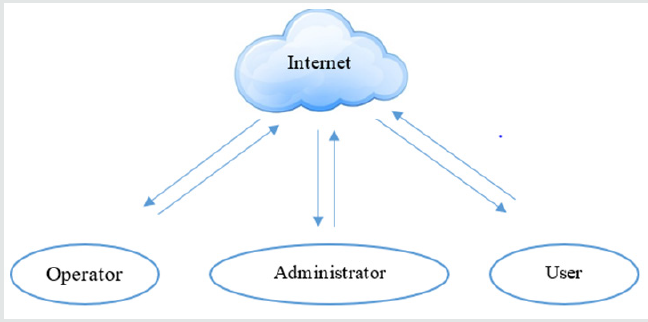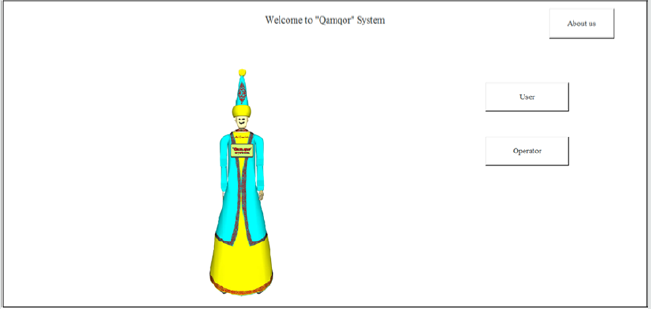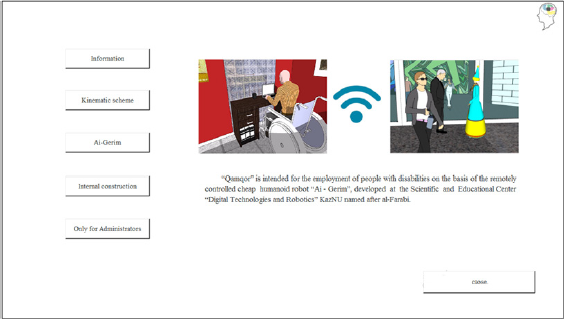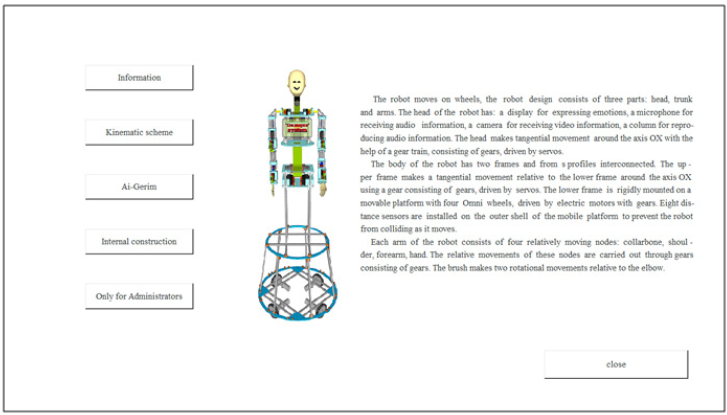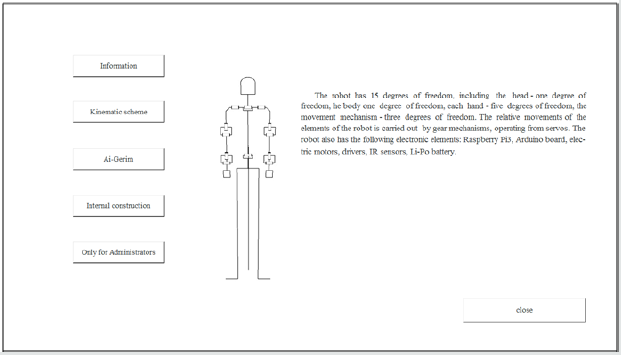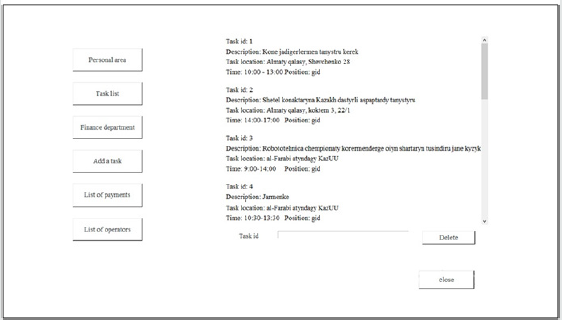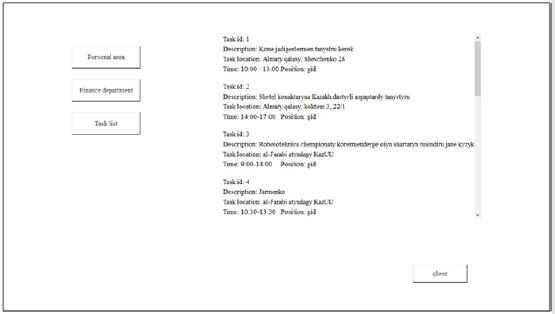
Lupine Publishers Group
Lupine Publishers
Menu
ISSN: 2643-6736
Review Article(ISSN: 2643-6736) 
Robotic System for Employment of People with Disabilities Volume 2 - Issue 4
Zhumadil Baigunchekov*, Zhadyra Zhumasheva, BekzaAmanov, ErnaZholdasov, Berik Sagitzhanov and Alibek Tleukhanov
- Al-Farabi Kazakh National University, Kazakhstan
Received: July 24, 2020; Published: July 29, 2020
Corresponding author: ZhumadilBaigunchekov, Scientific Educational Centre “Digital Technologies and Robotics”, Al- Farabi Kazakh National University, Almaty 050040, Kazakhstan
DOI: 10.32474/ARME.2020.02.000144
Abstract
Additive manufacturing is a promising technology in the fabrication of robotic components, because of its capability of producing complex net-shaped parts with less working procedures in combination with material science. In this review, different kinds of robotic components produced by additive manufacturing are presented, including parts of soft robots, components of multi-materials, and unibody robotic structures.
Keywords: Additive manufacturing; Robotic components; Soft robot
Introduction
Industrial robots have been used for a long time in many industries: in mechanical engineering, military-space industry, agriculture, etc. Since the 1990s, the development of service robots began, which do useful work for people, with the exception of industrial automation tasks, for example, robots - cleaners, robots - guides, robots-consultants. The development of service robots, in turn, led to the creation of social robots capable of social interactions with humans [1-9] for example, assistant - robots, companion - robots, robots for rehabilitation. Robot - assistants, in addition to performing basic functions, carry out social interactions with a person to provide assistance. For example, the humanoid robot “AVA” of the company “i-robot” [10], except for cleaning the house, collects information about the medical condition of its owner and transmits this data to the attending physician, robot - warden of Asian Forum for Corrections group [11], except for observation of convicts, mediates between prisoners and wardens, the humanoid robot Octavia [12] interacts with fireFigurehters when extinguishing a fire, robot Robonaut 2 [13] works on the NASA international space station, interacting with astronauts. Robots for rehabilitation support the mental health of people, especially the elderly, through communication, and also involve people with disabilities in public life (work, study, communication). Widely known is the robot - the baby seal Paro [14], which perceives people and the environment, demonstrates joy when it is ironed. This causes a calming effect and positive emotions in older adults and hospital patients.According to the international work organization, about 650 million people on our planet are with disabilities. In some countries, up to 80% of people with disabilities are unemployed. This is a big problem, since this category of people breaks away from social life. One of the directions to solve this problem is to attract people with disabilities to work and public life with the help of remotely controlled social robots. Remote control of such social robots by operators - people with disabilities, being at home, on the one hand attracts them to work and public life, and on the other hand, reduces the cost of robots. It is known that the bulk of the cost of robots operating offline is their control systems, for example, the cost of autonomous service robots Rob thespian (UK), Pepper (Japan), SANBOT Max (China), Promobot V.4 (Russia) are respectively 86486 USD, 34189 USD, 28194 USD, 19134 USD.This paper describes the “Qamqor” robotic system for employing people with disabilities. This system is created on the basis of the cheap developed remotely controlled social humanoid robot “Ai-Gerim,” which costs 3000 USD.
Qamqor System
The Qamqor system includes the following objects (Figure1):
a. Operator.
b. Administrator.
c. User.
The User is an institution (museum, supermarket, etc.) where
the robot “Ai - Gerim” is used as a guide, consultant, etc. The robot is
located in the User’s institution, here tasks are issued and the quality
of their implementation is checked, and payment is transferred to
the Operator through the Administrator for the completed task.
The Operator who is the person with disabilities, being at home,
remotely controls the robot via the Internet to complete the User’s
task and receives payment through the Administrator. Interaction
between the User, the Operator and the Administrator is carried out
via the Internet.
The Administrator has two departments: a technical
department and an information department with a server. The
technical department deals with the technical support of robots
and their serviceability. The information department is equipped
with a program written in Python, the first page of which is shown
in Figure 2. The “About us” pages contain information about the
“Qamqor” system (Figure3), as well as technical characteristics
(Figure 4), design (Figures 5&6) and On the “User” page (Figure
7) the institutions where the robots “Ai - Gerim” will be used are
registered and each User is automatically assigned a
Each User, by logging into his login, goes to the pages that
contain the following pages:
1. “Personal account” (Figure 8). Here information about the
User is presented, which can be changed. Changed information
is also changed on the server.
2. “Tasks” (Figure 9) The types of tasks, place and time of
their execution are indicated here. Each task has its own ID. The
user can delete the task by his ID.
3. “Payment” (Figure 10)Here, the User pays for the
completed task, which is carried out according to the available
task ID and the Operator.
4. “Adding tasks” (Figure 11) Here the User can add new
tasks. Added tasks are automatically entered into the list of
User and Operator tasks.
5. “List of payments” (Figure 12) Here is a list of payments
for completed tasks, indicating the Operator ID and the task.
6. “List of Operators” (Figure 13) Here is a list of all operators
with their ID and personal details.
The Operator enters the first page of the “Qamqor” system and
registers on the “Operator” page, receives his personal ID(Figure
14).
Each Operator, by entering his login, goes to the pages that
contain the following pages:
1. “Personal account” (Figure 15) Provides information
about the Operator that can be changed.
2. Tasks” (Figure 16) The types of tasks, locations and times
of their execution are indicated here.
3. “Payment” (Figure17) The ID of the completed task and
the amount of payment are
Let’s consider the work of the “Qamqor” system in the following
example.
1. Let 10 “Ai-Gerim” robots be manufactured at the initial
stage and provided to 10 Operators free of charge. Since the
“Ai-Gerim” robot is a proprietary design and licenses are not
required for their manufacture, and the cost of one robot is
3000 USD, the sum of manufacturing 10 robots is 3000 USD.
2. 10 Operators with robots “Ai-Gerim” areemployed by
Users from home, with a monthly payment of 300 USD.
3. Each Operator uses 150 USD monthly for himself, and 150
USD is transferred to the Administrator’s Accumulation Fund.
4. After 20 months, the amount of the Savings Fund is USD
30,000.
5. Consequently, in 20 months the cost of ten robots will pay
off or 10 new robots will be manufactured at the expense of
theAccumulation Fund and 10 new Operators will be provided
with work.
The relationship between the Operator, the User and the
Administrator is carried out by the “Qamqor” system. With the
help of this system, the Operator, while at home, by transmitting
and receiving audio and video information, controls the robot “Ai -
Gerim” to perform the tasks of the User. For this purpose, in front of
the robot, a Full HD touch screen with a resolution of 1920 x 1080
is installed with the application of social networks and Skype, a
video camera, a display, a speaker, a microphone. Information about
tasks, locations of their execution and payment is entered by the
User into the system. The Administrator delivers the robot, through
the system regulates the relationship between the User and the
Operator, provides a service to improve the qualifications of the
Operator.
Conclusion
The “Qamqor” robotic system uses a low-cost social humanoid robot “Ai - Gerim” to provide employment for people with disabilities. This robot is located at the user’s premises, where it performs services and is remotely controlled by a disabled human operator while at home. Remotely controlled social robots are of great importance in the modern conditions of the coronavirus pandemic for the provision of non-contact medical and service services.
References
- Hegel F (2009) Understanding Social Robots. Second International Conference on Advances in Computer-Human Interactions pp.169-174.
- Duffy BR, Rooney C, O’Hare GM, O’Donoghe R (1999) What is a Social Robot? 10th Irish Conference on Artifical Intelligence & amp; Cognitive Science University College Cork Irland p. 96-118.
- Young JE (2011) Evaluating Human-Robot Interacting. International Journal of Social Robots 3(1): 53-67.
- Breazeal C (2004) Social Interactions in HRI: The Robot View. Systems, Man, and Cybernetics. Part C: Applications and Reviews 34(2): 143-166.
- Fong I, Nourbakhsh I, Dautenkahn K (2003) A Survey of Socially Interactive Robots. Robotics and Automation Systems 42(3): 143-166.
- Brazeal C (2003) Toward Sociable Robots. Robotics and Automation Systems 42(3):167-175.
- De Graaf MMA, Alltouch SB, van Dijk J (2015) What Makes Robot Social? A User’s Perspective on Characteristics for Social Human-Robot Interaction. Social Robotics pp. 184-193.
- Engelhardt KG, Edwards RA (1992) Human robot Integration for Service Robotics. Human- Robot Interaction. London pp. 315-346.
- Yang S (2015) Experiences Developing Socially Acceptable Interactions for a Robotic Trash Barrel. Robot and Human Interactive Communication (ROMAN), 24th IEEE International Symposium pp. 277-284.
- AVA Overview Irobot.
- Bloss R (2012) Robots Go to Prison-as Guards. An International Journal Industrial Robots 39: 148-158.
- Martinson E (2012) Fighting Fires with Human Robot Teams. IEEE / RSJ International Conference on Intelligent Robots and Systems pp. 2682-2683.
- Diftler MA (2011) Robonaunt 2-The First Humanoid Robot in Space. Robotics and Automation (ICRA), IEEE International Conference pp. 2178-2183.
- Sabanovis S (2013) Paro Robot Affects Divers Interaction Modalities in Group Sentory Therapy for Older Adult with Dementia. Rehabilitation Robotics (ICORR), IEEE International Conference p. 1-6.

Top Editors
-

Mark E Smith
Bio chemistry
University of Texas Medical Branch, USA -

Lawrence A Presley
Department of Criminal Justice
Liberty University, USA -

Thomas W Miller
Department of Psychiatry
University of Kentucky, USA -

Gjumrakch Aliev
Department of Medicine
Gally International Biomedical Research & Consulting LLC, USA -

Christopher Bryant
Department of Urbanisation and Agricultural
Montreal university, USA -

Robert William Frare
Oral & Maxillofacial Pathology
New York University, USA -

Rudolph Modesto Navari
Gastroenterology and Hepatology
University of Alabama, UK -

Andrew Hague
Department of Medicine
Universities of Bradford, UK -

George Gregory Buttigieg
Maltese College of Obstetrics and Gynaecology, Europe -

Chen-Hsiung Yeh
Oncology
Circulogene Theranostics, England -
.png)
Emilio Bucio-Carrillo
Radiation Chemistry
National University of Mexico, USA -
.jpg)
Casey J Grenier
Analytical Chemistry
Wentworth Institute of Technology, USA -
Hany Atalah
Minimally Invasive Surgery
Mercer University school of Medicine, USA -

Abu-Hussein Muhamad
Pediatric Dentistry
University of Athens , Greece

The annual scholar awards from Lupine Publishers honor a selected number Read More...




